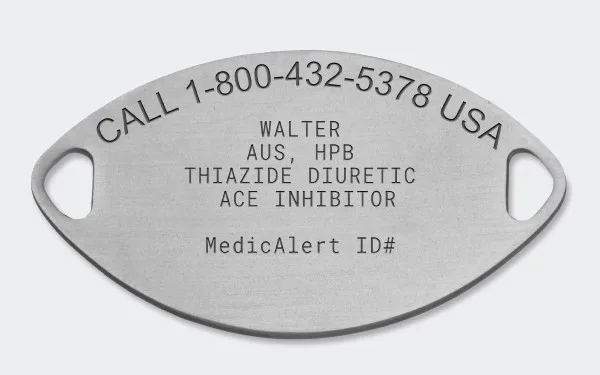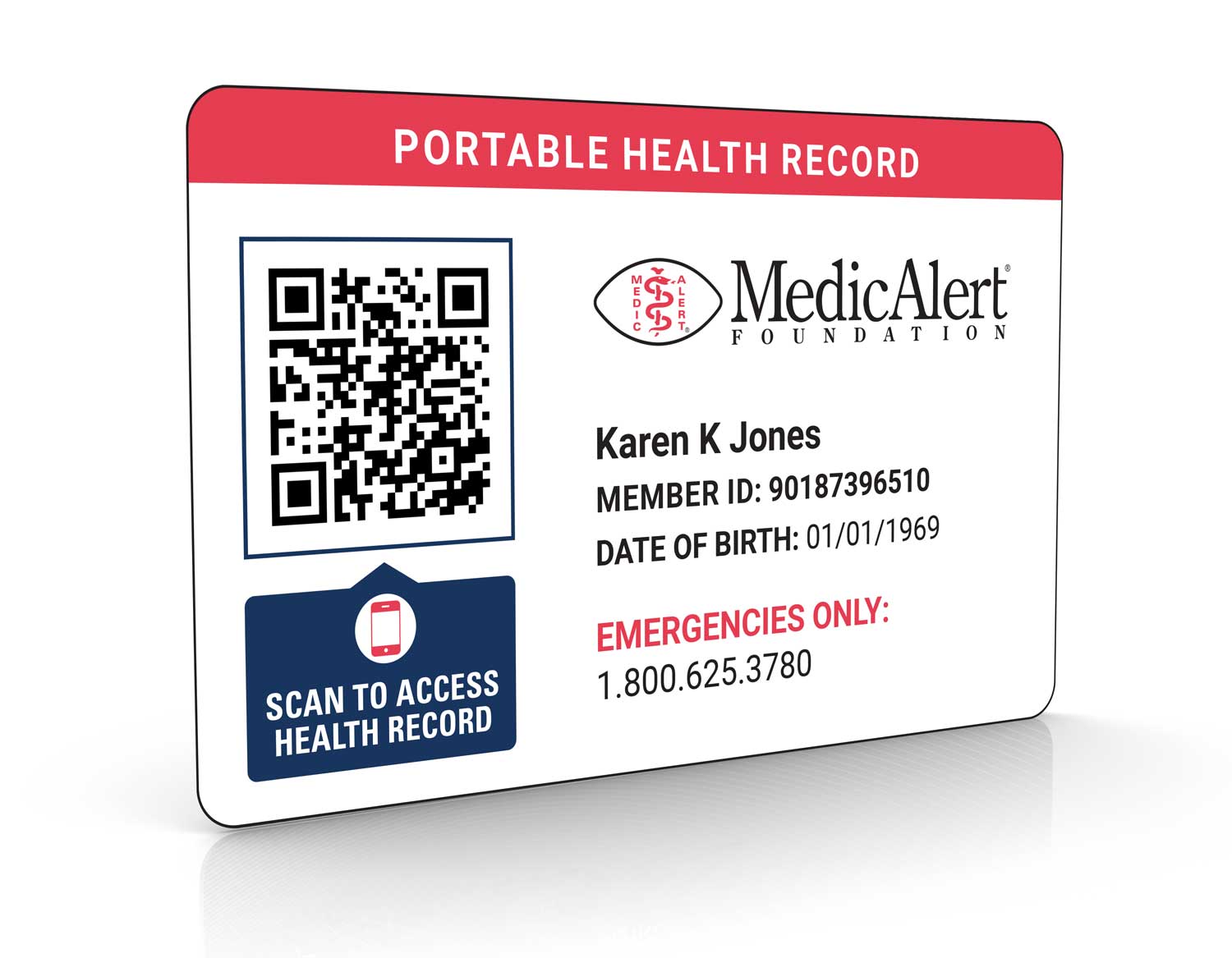Help others help you. Wear a medical alert ID bracelet or necklace engraved with important information for emergency responders and healthcare providers
Centers for Disease Control & Prevention

Medical IDs for Urinary Sphincter Implant
The confidence to live with urinary sphincter implant
Having control over your bladder is something a person can take for granted until it becomes a problem. Normally, a muscle called your urinary sphincter helps to control the flow of urine from your bladder. In cases where the urinary sphincter is not working correctly, an artificial urinary sphincter can be implanted to help you regain control.
Learning what to expect from a urinary sphincter implant and how to manage any complications can help you to lead a full and active life with this device.
Medical IDs for urinary sphincter implant are another way to ensure peace of mind. With a medical ID you know that any necessary medical treatment will go smoothly no matter what the situation is.
How MedicAlert protects those with urinary sphincter implant
If you have a urinary sphincter implant, it’s important to wear a medical ID bracelet so that first responders are aware of this device in any medical emergency. Adding a MedicAlert ID and Protection Plan gives you even more peace of mind so that you can live a full and active life.

24/7 Emergency Response
Our team provides first responders the information they need to provide fast, accurate care.

Digital Health Profile
All your vital information, all in one place for you and your caregiver.

Emergency Contact Notification
In an emergency, we connect families so that no one is alone in a crisis.

Emergency Contact Notification
In an emergency, we connect families so that no one is alone in a crisis.
Pair a medical ID for urinary sphincter implant with the protection plan that’s right for you.
What exactly is a urinary sphincter implant?
A urinary sphincter implant is a medical device that can be used to help control the flow of urine from your bladder. If your natural sphincter isn’t working correctly, leading to urinary incontinence (loss of control of urine), this artificial sphincter takes its place.
A urinary sphincter implant is made up of three parts:
- Urethral cuff– your urethra is the tube urine passes through. This cuff squeezes your urethra to control the flow of urine. It fills with fluid to close so urine can’t get through and empties to open so urine can leave the urethra.
- Pump– this is the part that allows fluid to enter or exit the urethral cuff. It moves fluid into or away from the urethral cuff. In men, it is placed in the scrotum, and in women, it can be placed under the skin of the lower belly or leg.
- Balloon– this is where the pump empties the fluid from the cuff when the cuff is open. It is implanted just under a person’s belly muscles.
Although urinary sphincter implants are mostly used for men after surgery to remove the prostate (prostatectomy), in some cases it is also used in women when other treatments to control urinary incontinence have failed. Over 250,000 artificial sphincters have been sold since it was invented in 1972.
Why would someone need a urinary sphincter implant?
As mentioned above, the most common reason for a urinary sphincter implant is prostatectomy, which causes urine leakage (incontinence) to be a problem during everyday living. This type of leakage is called stress incontinence and can happen during these activities:
- Coughing, sneezing, or laughing
- Bending over
- When lifting something heavy
- During exercise
- While having sex
What are the complications of a urinary sphincter implant?
Like any medical procedure, there can be complications with urinary sphincter implants. Thankfully, these problems are not common. The Mayo Clinic notes the most common complication is infection, in 3%-8% of patients. Other complications include:
- Pain
- Bleeding
- Damage to the urethra
- Continued problems with urine leaking or trouble holding in urine
- Malfunction of the artificial sphincter, requiring replacement surgery
- Trouble urinating
- Needing to use a catheter to empty your bladder
- Repeat surgeries to address problems including replacing the artificial sphincter at the end of its 8-10 year lifespan
What to engrave on your MedicAlert ID for urinary sphincter implant:
MedicAlert offers free custom engraving on all our urinary sphincter implant bracelets and medical ID products. Engravings on medical IDs for urinary sphincter implant should include any critical medical information that can protect and save lives in an accident or medical emergency, for example:
- Any medical conditions
- Medications
- Allergies
- Clearly identify the use of an artificial urinary sphincter
- The brand of artificial urinary sphincter you use

Sample engraving. Consult our team if you need help engraving your medical ID for urinary sphincter implant.
How is it determined that a urinary sphincter implant is needed?
If you are experiencing urine leakage, your healthcare provider can help determine if your natural urinary sphincter isn’t working right and you’re having stress incontinence. They can then advise you on whether a urinary sphincter implant would help. To diagnose stress incontinence, your doctor can:
- Ask you about your medical history and symptoms
- Perform a physical exam
- Ask you to keep a bladder diary to record your fluid intake, bathroom trips, and any urine leakage as well as activities before and during any accidents
They may also use the following tests to help pinpoint the problem:
- Urinalysis– to rule out infection or blood in the urine caused by other health problems
- Urinary pad test– an absorbent pad worn for 24 hours is used to measure how much urine leaks during that time
- Urodynamic testing– this is a series of tests that helps to measure neurologic and muscle function in the bladder as well as the flow of urine and bladder pressure to determine the cause of problems
- Bladder scan and ultrasound– a bladder scan is a brief look with ultrasound to see how the bladder empties; a more detailed ultrasound can look at the bladder, kidneys, and other pelvic organs
- Cystoscopy– this test uses a scope to look at the urinary tract
How do you manage, and live with a urinary sphincter implant?
The surgical procedure to place an artificial urinary sphincter is simple. While you are under anesthesia, two small surgical cuts are made to insert the artificial sphincter. Once you return home, avoiding strenuous activity is required for about 6 weeks, at which time your doctor will activate the device and teach you how to manage it.
Using the urinary sphincter implant is easy, with no special maintenance. Your doctor will ask you to report any signs of problems with the implant, including:
- A fever of 101 °F (38.3 °C) or higher
- Bleeding
- Swelling
- Pain that isn’t controlled with medication
- Severe bladder spasms (a cramping feeling)
- Difficulty urinating
An important part of managing a urinary sphincter implant is being sure that anyone providing medical care to you knows that you have the device and that a urinary catheter cannot be inserted without deactivating the cuff. Otherwise, serious and irreversible damage can happen.
In a medical emergency, you may not always be able to communicate this important detail to first responders. This is why it’s vital to always wear a MedicAlert ID that shares this information on your behalf. You can receive fast and accurate care with the right information available to healthcare professionals.

MedicAlert Foundation is proud to partner with NORD to provide support, educational resources and tools to help those affected by rare disease live more safely and confidently.
How a medical ID for urinary sphincter implant combined with MedicAlert Membership provides peace of mind
If you have a urinary sphincter implant, it’s important to wear a medical ID bracelet so that first responders are aware of this device in any medical emergency. All healthcare providers must know you have an artificial urinary sphincter so that they do not cause damage if they use a urinary catheter as part of your care.
A high-quality medical ID like the ones available from MedicAlert ensures that important details about your medical needs are shared quickly in an emergency, even if you are unable to relay the information yourself. Along with its globally recognized symbol for medical emergencies, a MedicAlert ID paired with a Protection Plan offers you a high level of support for your medical care.
MedicAlert Protection Plans include benefits such as:
- A robust digital health profile containing your medical history, medications, allergies, vaccinations, and more
- A 24/7 Emergency Response Team to relay vital information to first responders
- Emergency contact notification so your loved ones can be by your side quickly
- A printable patient profile that you can use for medical appointments
- Patient instructions that share information important to your care
- Document storage for medical device info like artificial urinary sphincter
- Sharing of your advance directives, such as DNR status
DISCLAIMER: THIS WEBSITE DOES NOT PROVIDE MEDICAL ADVICE. The information in this article is presented for educational purposes only and is not intended as a substitute for professional medical advice, diagnosis and treatment. Always seek the advice of a physician or other qualified healthcare provider for any questions you may have regarding a medical condition or treatment.







